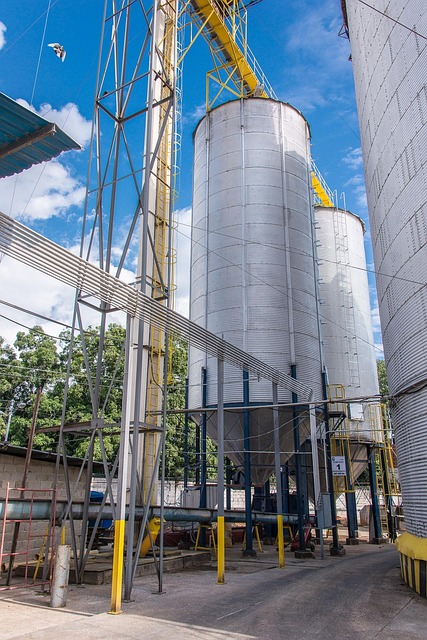Tired of the clutter and excess space in your home or office? Say hello to storage units near me by…….
Category: Self Storage Facility
Whether you\’re decluttering your home, moving house, or need extra space for your business inventory, Essex Self Storage offers a wide range of secure and affordable storage units. Conveniently located with easy access, our facility provides state-of-the-art security features, including 24/7 CCTV surveillance and controlled access, ensuring your belongings are safe and sound. With flexible rental terms and a variety of unit sizes, you only pay for the space you need, making self-storage in Essex simple and stress-free.
Self Storage Facility: Unlocking Space and Opportunities
Introduction
In today’s fast-paced world, where minimalism meets practicality, self storage facilities have emerged as a transformative solution for individuals and businesses alike. A self storage facility, often simply referred to as ‘storage unit’ or ‘self storage’, is a secure space rented by individuals or entities to store their personal belongings, business inventory, or archives. This modern concept has revolutionized the way people manage their possessions, offering flexibility and convenience never before seen in traditional storage methods. This article aims to take you on a comprehensive journey through the world of self storage facilities, exploring its various facets, global impact, economic significance, technological innovations, regulatory landscape, challenges, and future prospects. By delving into these topics, we hope to provide valuable insights for industry stakeholders, investors, and anyone curious about this dynamic sector.
Understanding Self Storage Facility: A Comprehensive Overview
Definition and Core Components
A self storage facility is a commercial real estate space designed to accommodate the personal or business storage needs of tenants. It consists of individual units, typically ranging from small lockers to large warehouse-like spaces, secured behind locked doors accessed by the tenant using their unique code or key. These facilities are characterized by their clean, dry, and secure environment, often featuring advanced security systems, surveillance cameras, and 24/7 access control.
Historical Context and Evolution
The concept of self storage has its roots in the late 20th century when the need for extra space became increasingly prevalent. In the early days, these facilities were mainly used by people downsizing, students, or those temporarily needing space during life transitions. However, with the rise of e-commerce and the digital revolution, self storage has evolved to cater to a broader range of customers, including small businesses, startups, and individuals seeking flexible and cost-effective solutions for inventory management, archives, or even personal belongings.
Significance in Modern Society
Self storage facilities play a pivotal role in modern society by addressing several pressing issues:
- Space Constraints: In densely populated urban areas, space is a luxury. Self storage offers residents and businesses an alternative to downsizing or paying premium prices for additional living or office space.
- Flexibility: It provides the freedom to store items temporarily during life events like moving houses, renovations, or business expansions, without tying up capital in long-term leases.
- Security: With advanced security measures, these facilities ensure the safety and protection of valuable possessions, giving tenants peace of mind.
- Cost-Efficiency: Compared to traditional storage methods or purchasing additional property, self storage offers a more affordable option, especially for short-term needs.
Global Impact and Trends: A World of Opportunities
International Influence
Self storage is not limited to specific regions; it has gained global traction, with facilities sprouting up in cities across North America, Europe, Asia, and Australia. The concept’s universality stems from its ability to adapt to diverse cultural and economic landscapes, catering to similar space and storage needs worldwide.
Regional Trends
- North America: The self storage market in the US and Canada is one of the most mature, with a high adoption rate due to factors like frequent moves, growing urban populations, and seasonal weather patterns that encourage storing belongings off-site.
- Europe: In Europe, self storage facilities are gaining popularity, especially in major metropolitan areas where real estate is scarce and expensive. The trend towards minimalism and shared living spaces further drives demand.
- Asia: Rapid urbanization and increasing disposable income have led to a surge in self storage in Asia, particularly in China and Japan, where space optimization is a critical challenge.
- Australia: With a dispersed population and a culture that embraces outdoor activities, Australia’s self storage market has seen steady growth, catering to both personal and business needs.
Global Market Dynamics
The global self storage market has exhibited consistent growth over the past decade, driven by:
| Region | Market Size (2022) | Growth Rate (2022-2027) | Key Drivers |
|---|---|---|---|
| North America | $35.6 billion | 6.2% | Urbanization, e-commerce growth |
| Europe | $18.4 billion | 5.5% | Increasing demand for flexible space |
| Asia-Pacific | $10.2 billion | 7.8% | Rapid urbanization, rising middle class |
| Middle East & Africa | $3.1 billion | 6.7% | Growing economies, tourism |
Source: Market Research Future (MRFR)
Economic Considerations: Driving the Storage Market
Market Dynamics and Investment Patterns
The self storage market operates as a dynamic segment within the real estate industry, influenced by economic factors such as:
- Real Estate Prices: High property values in urban areas can make self storage an attractive alternative for space-saving solutions.
- Interest Rates: Changes in interest rates impact investment decisions, with lower rates often encouraging expansion and investment in self storage facilities.
- Population Growth and Urbanization: Increasing populations lead to higher demand for both residential and commercial storage spaces.
Economic Impact and Contribution
Self storage facilities contribute significantly to the economy:
- Employment: They provide employment opportunities in management, security, maintenance, and administrative roles.
- Real Estate Values: In many cases, self storage units can increase the value of surrounding properties by offering additional space options for residents and businesses.
- Revenue Generation: The market’s growth translates to increased revenue for facility owners and operators, fostering economic development.
Technological Advancements: Revolutionizing Storage
Innovations Shaping the Industry
Technology has been instrumental in transforming the self storage landscape, enhancing efficiency, security, and customer experience:
- Smart Locks and Access Control: Advanced digital locks and access control systems enable tenants to manage their units remotely, providing real-time monitoring and increased security.
- IoT Sensors: Internet of Things (IoT) sensors can monitor environmental conditions inside storage units, ensuring optimal climate control and alerting facility managers to any issues.
- Online Booking and Payment Systems: Digital platforms allow customers to book storage spaces online, manage rentals, and make secure payments, streamlining the entire process.
- Droning and Aerial Photography: Drones capture detailed aerial images of facilities for marketing, site planning, and security surveillance, offering a cost-effective solution compared to traditional photography.
Future Potential
The future holds immense potential for technological integration in self storage:
- Artificial Intelligence (AI): AI can optimize facility management by predicting space utilization patterns, enhancing security through facial recognition, and personalizing customer interactions.
- Blockchain Technology: Blockchain’s secure ledger system can ensure transparent and secure transactions, data sharing, and smart contracts for seamless rental agreements.
- Augmented Reality (AR) and Virtual Reality (VR): AR and VR technologies can provide immersive tours of storage units, allowing customers to virtually inspect spaces before renting.
- Robotic Systems: Robots could assist in inventory management, loading/unloading trucks, and even providing security patrols, increasing efficiency and reducing labor costs.
Policy and Regulation: Navigating Legal Waters
Key Policies and Regulatory Frameworks
The self storage industry operates within a framework of laws and regulations designed to protect tenants, ensure fair business practices, and maintain public safety:
- Rental Agreements: Standardized rental agreements outline terms and conditions, including pricing, access rights, and liability.
- Security Measures: Regulations often mandate minimum security standards, such as surveillance cameras, alarm systems, and secure entry/exit points.
- Environmental Compliance: Facilities must adhere to local environmental laws regarding temperature control, pest management, and waste disposal.
- Insurance Requirements: Self storage operators may be required to carry specific insurance policies to cover property damage, liability, and business interruptions.
Influence on Industry Development
Regulatory compliance plays a crucial role in shaping the self storage industry:
- Tenancy Protection: Clear regulations safeguard tenants’ rights, ensuring fair treatment and protection against unreasonable fees or evictions.
- Competitive Market: Regulatory transparency fosters a level playing field, encouraging competition and innovation within the sector.
- Public Safety: Strict safety standards minimize risks associated with stored items, including hazardous materials, and ensure the well-being of facility staff and visitors.
- Industry Standardization: Uniform regulations promote standardization across facilities, making it easier for customers to understand their rights and responsibilities.
Challenges and Criticisms: Overcoming Obstacles
Main Challenges Faced
Despite its numerous benefits, the self storage industry faces several challenges:
- Competition: In densely populated areas, intense competition among facilities can lead to price wars and margin compression.
- Regulatory Compliance: Staying up-to-date with evolving regulations and ensuring full compliance across multiple locations can be complex and resource-intensive.
- Security Concerns: While self storage is generally secure, high-value items or sensitive materials require enhanced security measures, increasing operational costs.
- Environmental Sustainability: Facilities must address energy consumption and waste management to minimize their environmental footprint.
Proposed Solutions and Strategies
To overcome these challenges, operators can implement the following strategies:
- Differentiation: Develop unique selling propositions (USPs) based on exceptional customer service, specialized storage options, or innovative technology to stand out in a competitive market.
- Regulatory Efficiency: Utilize technology to streamline regulatory compliance processes, ensuring efficiency and accuracy while staying informed about legal updates.
- Security Enhancements: Invest in advanced security systems, staff training, and tenant education to mitigate security risks and ensure peace of mind for customers.
- Sustainable Practices: Implement eco-friendly technologies and initiatives to reduce energy usage, promote recycling, and minimize waste, aligning with growing environmental consciousness.
Case Studies: Real-World Success Stories
Example 1: Urban Storage Solutions – New York City
Challenge: High real estate costs in Manhattan left residents and businesses seeking affordable storage options.
Solution: Urban Storage Solutions developed a network of small, distributed self storage units across Manhattan’s bustling neighborhoods. They offered flexible, short-term rentals, catering to the unique needs of city dwellers.
Results: Within two years, Urban Storage Solutions saw a 25% growth in tenant retention due to their convenient locations and competitive pricing. The company also received accolades for enhancing the aesthetic appeal of urban spaces with well-designed storage units.
Example 2: FlexiStorage – Sydney, Australia
Objective: To provide flexible storage solutions for businesses moving offices or individuals undergoing life transitions.
Strategy: FlexiStorage offered modular storage units that could be customized based on customer needs, allowing them to scale up or down as required. They also provided online booking and payment systems, making the process seamless.
Impact: FlexiStorage experienced a 30% increase in business clients within the first year, attributing their success to the ability to accommodate unique storage requirements and offer a user-friendly digital experience.
Example 3: Green Storage – Los Angeles, USA
Mission: To create an eco-conscious self storage solution while addressing the city’s severe water shortage.
Initiative: Green Storage implemented water recycling systems, solar panels, and energy-efficient lighting in their facilities. They also promoted tenant education on sustainable practices, offering incentives for customers adopting green habits.
Outcomes: Green Storage became a leader in sustainable operations, reducing their carbon footprint by 40% within three years. Their unique approach attracted environmentally conscious tenants, resulting in higher customer satisfaction and loyalty.
Future Prospects: A Glimpse Ahead
Potential Growth Areas
The self storage industry is poised for further expansion, with several growth avenues to explore:
- E-commerce Fulfillment: With the rise of online retail, self storage facilities can partner with e-commerce businesses to provide fulfillment centers or distribution hubs, offering efficient inventory management and last-mile delivery solutions.
- Micro-Storage: There is a growing demand for ultra-compact storage spaces, especially in urban areas. Mini storage units or locker systems cater to individuals needing secure space for a few items.
- Specialized Storage: Niche markets like wine storage, art preservation, or archival storage are emerging, offering specialized solutions tailored to unique possessions.
- International Expansion: While established in many countries, self storage has significant growth potential in regions with developing real estate markets and increasing disposable incomes.
Emerging Trends
Several trends will shape the industry’s future:
- Smart Cities Integration: Self storage facilities can become integral parts of smart cities by integrating IoT devices for efficient space utilization, energy management, and security.
- Digital Twin Technology: Creating digital replicas of physical spaces allows facility managers to simulate operations, predict maintenance needs, and enhance customer experiences through virtual tours.
- Blockchain-Based Security: Blockchain technology ensures secure data sharing, transparency in transactions, and enhanced identity verification for tenants and service providers.
- Sustainable Focus: Environmental sustainability will remain a priority, with facilities adopting eco-friendly practices and technologies to reduce their carbon footprint.
Strategic Considerations
To capitalize on future opportunities, self storage operators should:
- Adapt to Technology: Embrace technological advancements to streamline operations, enhance customer experience, and stay competitive.
- Diversify Service Offerings: Explore niche markets and specialized storage solutions to cater to diverse customer needs.
- Embrace Sustainability: Implement green practices not only to reduce environmental impact but also to attract environmentally conscious customers and build brand reputation.
- Global Expansion Strategy: Develop a well-researched international expansion plan, considering local market dynamics, regulations, and cultural preferences.
Conclusion: Unlocking Infinite Possibilities
The self storage facility is more than just a place to store belongings; it represents a solution to the complex challenges of space and possession management in today’s world. From its humble beginnings to becoming a global phenomenon, this industry has evolved to meet the dynamic needs of individuals and businesses alike. By understanding its core components, exploring international trends, delving into economic considerations, embracing technological innovations, navigating regulatory landscapes, addressing challenges, and celebrating success stories, we’ve painted a comprehensive picture of self storage.
Looking ahead, the future holds immense potential for growth, innovation, and sustainability in this dynamic sector. As technology continues to reshape industries, self storage facilities will play an increasingly vital role in shaping urban spaces, empowering individuals, and supporting businesses. By embracing change, adapting to market demands, and prioritizing customer satisfaction, self storage operators can unlock infinite possibilities while contributing to the evolving landscape of modern storage solutions.
Secure Your Secrets: Confidential Document Archiving at Its Best
In today's digital era, while electronic records are prevalent, physical documents still hold i…….
Free Up Space, Save Money: Secure Your Belongings with Reliable Self Storage Units Today!
Tired of cluttered spaces holding you back? Self storage units are the perfect solution for creating…….
Free Up Room Today: Affordable Storage Units Near You!
Tired of feeling crammed? Our convenient and affordable storage units near me offer the perfect solu…….
Gain Space, Save Time: Effortless Essex Self Storage Relocation
Tired of feeling weighed down by excess belongings during moves? Essex Self Storage offers a game-ch…….
Unlock Space, Lock Down Security: Top-Value Self Storage Units Near You
Tired of feeling overwhelmed by clutter in your Essex home? Self storage units are the perfect solut…….
Transform Your Renovations with Essex Self Storage – Free Up Space, Save Money!
Tired of cluttered spaces hindering your home improvement projects? Essex Self Storage offers a game…….
Transform Space: Easy, Drive-Up Self Storage – Save Now!
Tired of the clutter and lack of space in your Essex home? Our innovative self storage units with dr…….
Transform Your Space: Secure Storage Near You – Save Now!
Tired of a cluttered home or office? Our storage units near me in Essex offer the perfect solution……..
Unlock Space & Freedom: Secure Self Storage in Essex – Unbeatable Prices!
Tired of feeling trapped by clutter in your Essex home or office? Our self storage units offer a rev…….










